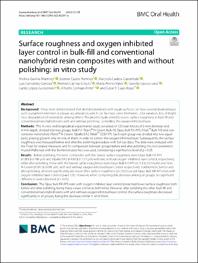Mostrar el registro sencillo del ítem
Surface roughness and oxygen inhibited layer control in bulk‑fll and conventional nanohybrid resin composites with and without polishing: in vitro study
| dc.contributor.author | Gaviria‑Martinez, Andrea | |
| dc.contributor.author | Castro‑Ramirez, Leonor | |
| dc.contributor.author | Ladera‑Castañeda, Marysela | |
| dc.contributor.author | Cervantes‑Ganoza, Luis | |
| dc.contributor.author | Cachay‑Criado, Hernán | |
| dc.contributor.author | Alvino‑Vales, María | |
| dc.contributor.author | Garcia‑Luna, Goretty | |
| dc.contributor.author | López‑Gurreonero, Carlos | |
| dc.contributor.author | Cornejo‑Pinto, Alberto | |
| dc.contributor.author | Cayo‑Rojas, César F. | |
| dc.date.accessioned | 2022-07-01T20:25:03Z | |
| dc.date.available | 2022-07-01T20:25:03Z | |
| dc.date.issued | 2022-06-26 | |
| dc.identifier.uri | https://hdl.handle.net/20.500.14308/3812 | |
| dc.description.abstract | Background: It has been demonstrated that dental restorations with rough surfaces can have several disadvantages such as pigment retention or plaque accumulation, which can facilitate caries formation, color variation, loss of bright‑ ness, degradation of restoration, among others. The present study aimed to assess surface roughness in bulk fll and conventional nanohybrid resins with and without polishing, controlling the oxygen inhibited layer. Methods: This in vitro and longitudinal experimental study consisted of 120 resin blocks of 6 mm diameter and 4 mm depth, divided into two groups: Bulk Fill (Tetric® N-Ceram Bulk-fll, Opus Bulk Fill APS, Filtek™ Bulk Fill) and con‑ ventional nanohybrid (Tetric® N-Ceram, Opallis EA2, Filtek™ Z250 XT). Each resin group was divided into two equal parts, placing glycerin only on one of them, in order to control the oxygen inhibited layer. Subsequently, the surface roughness was measured before and after the polishing procedure with Sof-Lex discs. The data were analyzed with the T-test for related measures, and for comparison between groups before and after polishing, the non-parametric Kruskal Wallis test with the Bonferroni post hoc was used, considering a signifcance level of p<0.05. Results: Before polishing, the resin composites with the lowest surface roughness were Opus Bulk Fill APS (0.383±0.186 µm) and Opallis EA2 (0.430±0. 177 µm) with and without oxygen inhibited layer control, respectively; while after polishing, those with the lowest surface roughness were Opus Bulk Fill APS (0.213±0.214 µm) and Tetric N-Ceram (0.097±0.099 µm), with and without oxygen inhibited layer control, respectively. Furthermore, before and after polishing, all resins signifcantly decreased their surface roughness (p<0.05) except Opus Bulk Fill APS resin with oxygen inhibited layer control (p=0.125). However, when comparing this decrease among all groups, no signifcant diferences were observed (p<0.05). Conclusion: The Opus Bulk Fill APS resin with oxygen inhibited layer control presented lower surface roughness both before and after polishing, being these values similar at both times. However, after polishing the other bulk fll and conventional nanohybrid resins with and without oxygen inhibited layer control, the surface roughness decreased signifcantly in all groups, being this decrease similar in all of them. | es_PE |
| dc.format | application/pdf | es_PE |
| dc.language.iso | en | es_PE |
| dc.publisher | BMC Oral Health | es_PE |
| dc.rights | info:eu-repo/semantics/openAccess | es_PE |
| dc.rights | Attribution-NonCommercial-NoDerivs 3.0 United States | * |
| dc.rights.uri | http://creativecommons.org/licenses/by-nc-nd/3.0/us/ | * |
| dc.source | Universidad Privada San Juan Bautista | es_PE |
| dc.source | Repositorio institucional - UPSJB | es_PE |
| dc.subject | Resina de relleno a granel | es_PE |
| dc.subject | Estudio comparativo | es_PE |
| dc.subject | Materiales dentales | es_PE |
| dc.subject | Pulido dental | es_PE |
| dc.subject | Odontología | es_PE |
| dc.subject | Resina nanohíbrida | es_PE |
| dc.subject | Oxígeno capa inhibida | es_PE |
| dc.subject | Compuesto de resina | es_PE |
| dc.subject | Rugosidad de la superficie | es_PE |
| dc.title | Surface roughness and oxygen inhibited layer control in bulk‑fll and conventional nanohybrid resin composites with and without polishing: in vitro study | es_PE |
| dc.type | info:eu-repo/semantics/article | es_PE |
| dc.date.embargoEnd | 2022-07-01 | |
| dc.type.version | info:eu-repo/semantics/acceptedVersion | es_PE |



